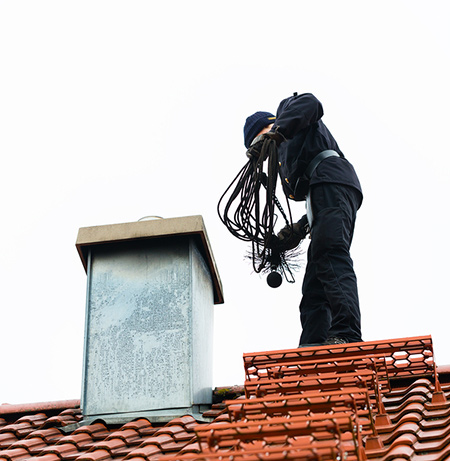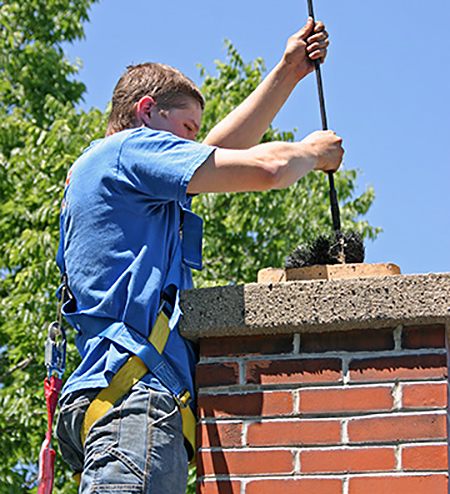The Truth About Chimney Cleaning Logs
 “If I regularly use Chimney Cleaning Logs or Creosote Sweeping Logs, do I still need to schedule an annual chimney inspection and cleaning?” We hear this question frequently from our customers at Burlington Fireplace & Heating.
“If I regularly use Chimney Cleaning Logs or Creosote Sweeping Logs, do I still need to schedule an annual chimney inspection and cleaning?” We hear this question frequently from our customers at Burlington Fireplace & Heating.
The answer is simple: Yes. Even if you burn chimney sweep logs regularly, you could still have a chimney fire or suffer from carbon monoxide poisoning because of a damaged or blocked chimney.
Why Chimneys Need to be Cleaned & Inspected
There are three reasons why it is important to have your home’s chimney cleaned and inspected at least once a year:
1. Blocked Chimney
Animal nests, leaves and other debris can collect in the top of a chimney. When this happens, it traps smoke and carbon monoxide in the chimney and forces it back down into your home. Carbon monoxide is a poisonous gas that is odorless and tasteless. If you are using a fireplace with a partially blocked chimney, you might not even realize that carbon monoxide is accumulating in your home unless you have a carbon monoxide detector.
2. Structural Damage
Over time, the flue lining in a chimney can become damaged. If there are cracks or gaps in your flue lining it can cause health and safety risks such as allowing dangerous gases to escape back into your home and allowing creosote to build up outside the lining of the flue. Even if you do not use your chimney, a cracked flue lining that is not fixed can deteriorating the structure of your chimney from the inside out. Repairing the masonry of a chimney that has been damaged from a leaked flue can be incredibly expensive.
3. Creosote Build Up
Creosote is a highly combustible compound that is created when you burn wood or firelogs in a fireplace, wood burning stove or fireplace insert. It collects along the flue walls inside of a chimney.
When there are large amounts of creosote in a flue, the chance of a chimney fire increases. A stray spark or even a high temperature in the flue produced by an especially hot fire can ignite a deposit of creosote resulting in a chimney fire that could damage the structure of your chimney along with interior walls in your home, insulation and other flammable materials surrounding the chimney.
How Chimney Cleaning Logs Work
Creosote Sweeping Logs are only able to help with the last issue.
According to the Creosote Sweeping Logs’ website, their log “Treats and reduces existing creosote in your chimney” and “Reduces new creosote build-up, making your next fire safer.” The way it does this is through “special minerals” or chemicals that are released when the log is burned. These chemicals react with the creosote deposits in your chimney and, over time, can make the creosote become brittle so that it flakes off the flue walls.
While they advertise that these flakes of creosote are “less flammable,” it is important to realize that even these flakes of creosote will still be extremely combustible.
Ideally, these flakes of creosote would fall down into the hearth where they could be swept up and thrown away. Unfortunately, most flues are not built to be completely straight. They bend and curve on the way up to the top of the chimney. Because of this, even when the chemicals in a Creosote Sweeping Log are able to effectively loosen creosote deposits from the lining of the flue walls, the flakes of creosote may collect in the bends and curves in the flue instead of falling into the hearth. If your flue is not manually cleaned out, these deposits of creosote flakes can cause a dangerous and damaging chimney fire. Also, not all creosote deposits will be effected by the chemicals in the log. Your chimney could still have large deposits of it after burning one of these logs.
Both the non-profit, educational institution the Chimney Safety Institute of America (CSIA) and the Washington Public Fire Educators (WPFE), which is made up of professional fire fighters, have concluded:
“The use of [Creosote Sweeping logs] alone is not an adequate substitute for mechanical chimney cleaning and inspection because it does not provide for the same level of protection to the chimney system.”
We have answered calls from terrified homeowners who have had disastrous chimney fires even though they used creosote sweeping logs.
 Regularly using a Creosote Sweeping Log may reduce the buildup of creosote in your chimney but it is still important to have your chimney cleaned by a certified chimney sweep who can remove all of the creosote, any debris that has collected around the top and will inspect it for structural and safety issues. After using your fireplace, fireplace insert or stove throughout the cold weather months, it is smart to have your chimney cleaned and inspected when the weather becomes warmer.
Regularly using a Creosote Sweeping Log may reduce the buildup of creosote in your chimney but it is still important to have your chimney cleaned by a certified chimney sweep who can remove all of the creosote, any debris that has collected around the top and will inspect it for structural and safety issues. After using your fireplace, fireplace insert or stove throughout the cold weather months, it is smart to have your chimney cleaned and inspected when the weather becomes warmer.
If you live in the Greater Milwaukee area—from Port Washington, WI to Elkhorn, WI and out west to Lake Geneva, Janesville, Racine, and Burlington, WI—we would be happy to serve you! Our certified chimney technicians take pride in providing outstanding customer service at an affordable price.
